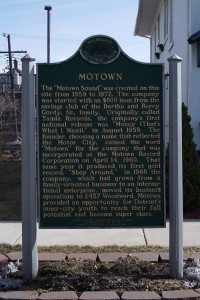Well after much speculation, I’ve decided to focus on Civil Rights in a round about way for my individual project. I recently visited the Motown Museum in Detroit with some friends for the first time (which is also one of Michigan’s Historical Sites as well).
If you drove down Grand Boulevard, you would probably miss this house unless there was a gaggle of tourists sitting on the front lawn at the time of your passing. It fits right in between the other buildings with just a small parking lot on the side. After taking the mandatory picture of ourselves in front of Hitsville, we decided to go ahead and actually go in the museum. (YES, I am a history major, but NO I had not came with the intention of actually visiting the museum thinking it was more of a tourist trap than museum). After seeing that it would cost $10, my poor college student instincts kicked in and said to myself, “there is no way I am paying $10 to walk through this house.” Wrong. I did pay the $10 and the cashier decided to tell me AFTER she had ran my debit card when I asked about discounts for school field trips that there were also discounts for college students (this was after we had also said we were from MSU). So, anyways, I paid the $10 and life goes on. The museum visit also comes with a tour, which I am generally never thrilled about. I was wrong.
The tour made the museum visit. I would not have gotten nearly as much without the help of the tour guide. Not only was he very informative, but he was very entertaining. It made every exhibit seem interactive. So, if you decide to head over to the museum, pay the $10 and tap into the knowledge of the people who work there. You won’t regret it. While some parts are slightly “touristy,” they are entertaining. They pull people in and keep you there. And isn’t that an important mission of any museum -to have visitors?
However, what really struck me was the ingenuity of Berry Gordy (founder of Motown). I had know that racism affected the industry and creation of Motown; however, I was incredibly interested as the tour guide explained how Berry Gordy changed the industry to work arouond racism (how it affected the ways he “trained” singers, the way album covers were designed, etc.) and also how the indurstry worked to combat racism.
It was this that led me to the topic for my lesson plan. I want to focus on different areas where this occured besides Motown (sports, literature, education, social groups, whatever). Students always learn about Martin Luther King, Jr. and Rosa Parks. That is not to say that they were not important, but I want to supplement that knowledge. What were other people doing in other areas?
And just to explain the title of this post and for a little fun…




